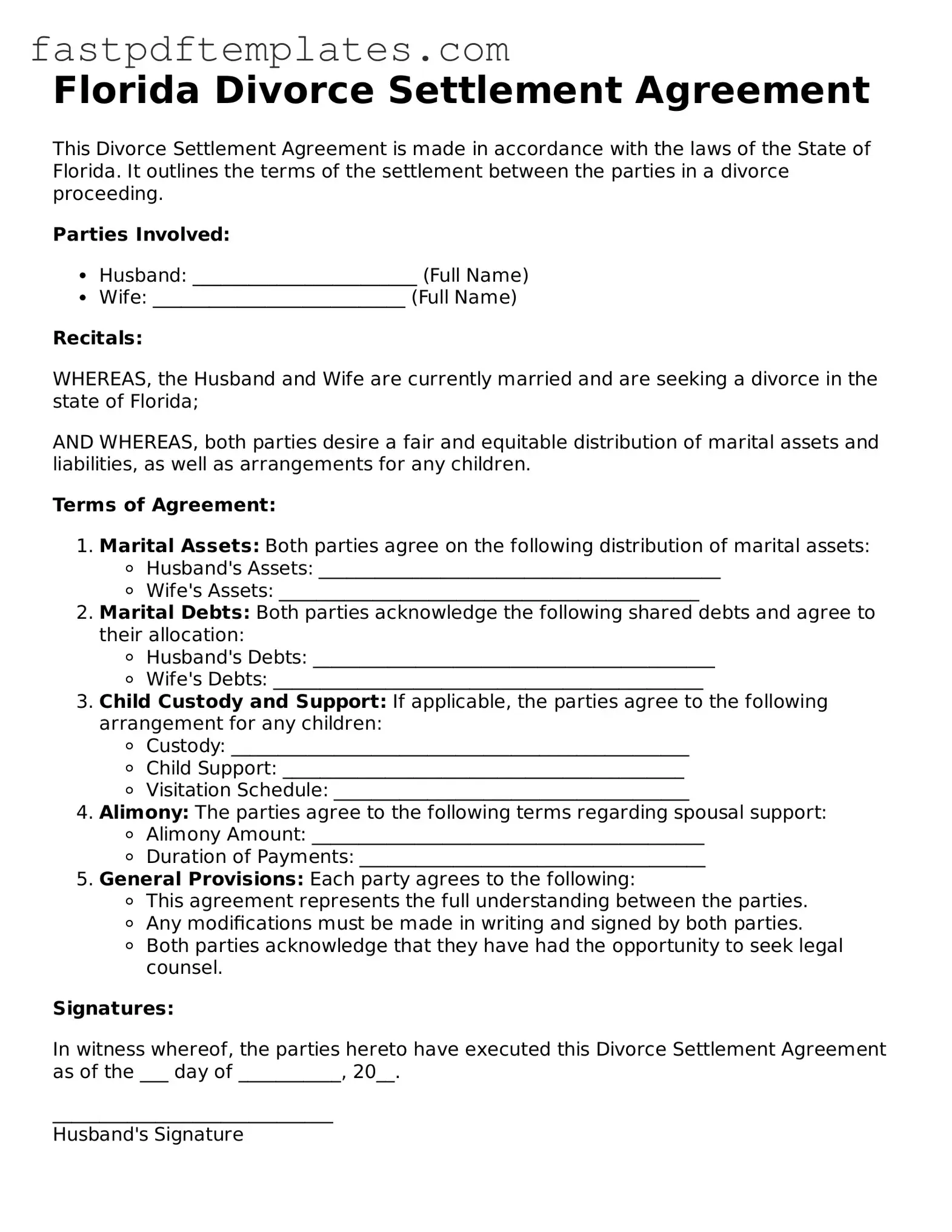The Florida Divorce Settlement Agreement form shares similarities with a Marital Settlement Agreement. Both documents serve as a comprehensive outline of the terms agreed upon by spouses during a divorce. They detail issues such as property division, child custody, and support obligations. The primary difference lies in the jurisdiction; while the Florida form is specific to that state, a Marital Settlement Agreement can be used in various states, adapting to local laws and requirements.
Another document akin to the Divorce Settlement Agreement is the Separation Agreement. This document is often utilized when couples decide to live apart but are not yet ready to divorce. Like the Divorce Settlement Agreement, it addresses property division, child custody, and support. However, the Separation Agreement is temporary and can be modified or dissolved if the couple reconciles or proceeds with divorce.
The Child Custody Agreement is also similar, focusing specifically on the arrangements for children involved in a divorce. This document outlines custody arrangements, visitation schedules, and parenting responsibilities. While the Divorce Settlement Agreement includes child custody provisions, the Child Custody Agreement is dedicated solely to these issues, ensuring clarity and focus on the children's best interests.
A Property Settlement Agreement shares similarities with the Divorce Settlement Agreement as well. This document specifically addresses the division of marital assets and debts. It is often part of a broader divorce settlement but can stand alone if the parties reach an agreement on property matters before finalizing their divorce. Both documents aim to ensure a fair distribution of assets, but the Property Settlement Agreement is narrower in scope.
The Parenting Plan is another document that aligns closely with the Divorce Settlement Agreement. It provides a detailed framework for co-parenting after divorce, including schedules, decision-making responsibilities, and communication guidelines. While the Divorce Settlement Agreement may touch on parenting issues, the Parenting Plan focuses exclusively on the ongoing relationship between parents and children, emphasizing cooperation and stability for the kids.
The Alimony Agreement is also relevant, as it specifically addresses spousal support. This document outlines the terms under which one spouse will provide financial support to the other post-divorce. While the Divorce Settlement Agreement may include alimony provisions, the Alimony Agreement focuses solely on this financial aspect, detailing the amount, duration, and conditions of support.
The Quitclaim Deed can be compared to the Divorce Settlement Agreement in terms of property transfer. This document is used to transfer ownership of real estate from one spouse to another as part of the divorce settlement. While the Divorce Settlement Agreement outlines the terms of property division, the Quitclaim Deed is the legal mechanism that executes the transfer of property rights, ensuring that both parties fulfill their agreed-upon terms.
The Financial Affidavit is another document that complements the Divorce Settlement Agreement. It requires both parties to disclose their financial situations, including income, expenses, assets, and liabilities. This transparency is crucial for fair negotiations regarding support and property division. The Divorce Settlement Agreement relies on the information provided in the Financial Affidavit to craft equitable terms based on each spouse's financial standing.
Lastly, the Court Order of Dissolution is a critical document that finalizes the divorce process. It incorporates the terms agreed upon in the Divorce Settlement Agreement and is issued by the court. This order legally dissolves the marriage and enforces the agreements made regarding custody, support, and property division. While the Divorce Settlement Agreement outlines the parties' wishes, the Court Order of Dissolution translates those wishes into legally binding obligations.
